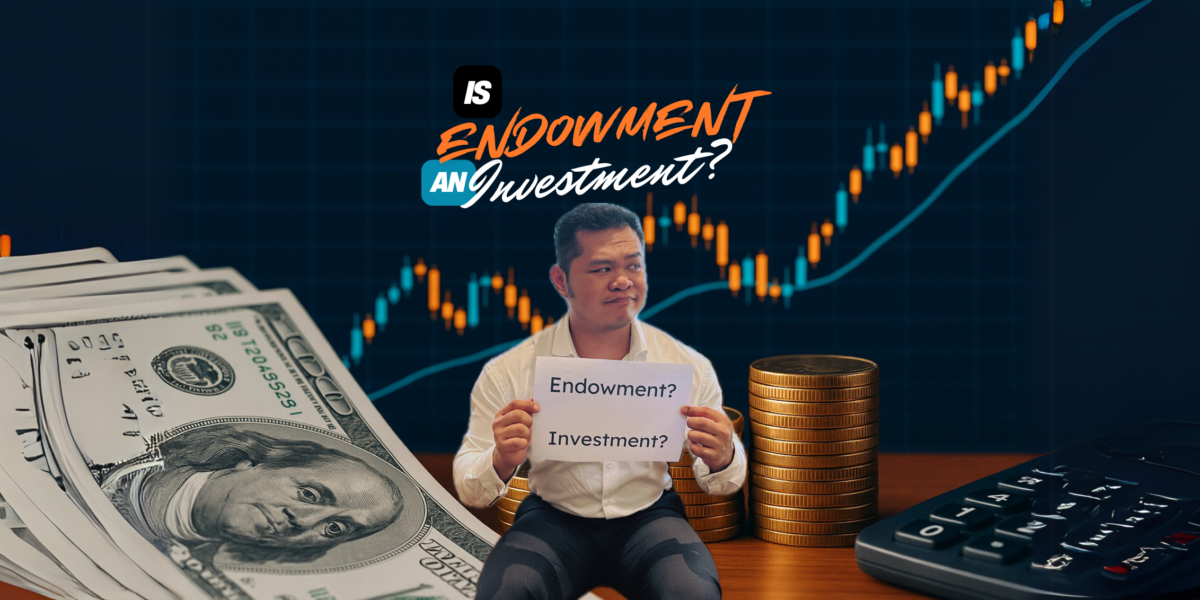Hello everyone!
If you’ve ever sat down for a financial consultation, chances are you’ve heard the word endowment. It’s one of the tools often recommended for people looking to grow their money in a stable and structured way. A question I often get from my prospects is: “Is an endowment plan like a bank savings account, or is it considered an investment?”
Let’s clear that up — an endowment plan is indeed a type of investment product, although it works quite differently from your usual investments like mutual funds or ETFs. What makes it unique is that it comes with insurance features and channels your money into something called a participating fund.
An endowment is best described as an insurance-wrapped savings product. You commit to contributing regularly — either monthly or annually — and in return, you receive a lump sum payout at the end of the policy term. Some policies even let you make partial withdrawals or partial surrenders after a certain number of years. Your total return is made up of guaranteed returns and non-guaranteed bonuses, making it a relatively low-to-moderate risk option. Most endowment plans also include basic insurance coverage, usually for death, and sometimes for total permanent disability or terminal illness.

🏦 What is a Participating Fund (Par Fund)?
A participating fund is a large pool of money managed by the insurer. When you purchase an endowment or a whole life policy, your premiums go into this fund. The insurer invests this pool of money to generate long-term returns. While you don’t directly own the investments, you participate in the profits through declared bonuses. That’s why it’s called a participating policy.
The return is made up of two parts:
- Guaranteed returns
- Non-guaranteed bonuses (depending on how well the fund performs)

📈 What Do Participating Funds Invest In?
Participating funds are designed to grow steadily while managing risk. The fund is typically diversified as follows:
- 50%–70% in government and corporate bonds for steady income
- 10%–30% in equities (stocks) for growth
- 5%–15% in property for long-term capital appreciation
- 1%–10% in cash or money market instruments for liquidity
This mix allows the fund to deliver stable performance even during market fluctuations.

🔍 How Is a Par Fund Different from ETFs or Mutual Funds?
Here’s how par funds compare to ETFs and mutual funds:
1. Ownership of Investment
- Par Fund: You don’t own the underlying investments. You own a policy that shares in the fund’s returns.
- ETF/Mutual Fund: You own actual units of the investments. You can track your holdings daily.
2. Availability & Liquidity
- Par Fund: Not market-traded. Locked in for a term (e.g. 10–20 years). Early withdrawal may incur penalties.
- ETF: Highly liquid and traded like stocks.
- Mutual Fund: Medium liquidity. Bought and sold through fund platforms.
3. Capital Protection
- Par Fund: Often offers partial or full capital guarantee at maturity.
- ETF/Mutual Fund: No capital guarantee. Value depends on market performance.
4. Insurance Coverage
- Par Fund: Includes insurance protection (e.g. death, critical illness).
- ETF/Mutual Fund: No insurance element.
Because of these differences, par funds are ideal for people who prefer stable, long-term savings with insurance bundled in.
🎁 Types of Bonuses in Endowment Plans
So far, you know your total return comes from guaranteed and non-guaranteed components. Here are the typical types of bonuses:
- Guaranteed Maturity Benefit: The minimum sum promised if you hold the policy till maturity. This is guaranteed.
- Reversionary Bonus: Declared annually. Once declared, it becomes guaranteed and added to your policy value.
- Cash Bonus: Some plans offer annual cash payouts. You can spend it or leave it to accumulate with interest. Not guaranteed.
- Terminal Bonus: A one-time bonus paid upon maturity, surrender, or death. Not guaranteed and subject to change.

🛡️ Why Are Reversionary Bonuses Guaranteed After Declaration?
Once a reversionary bonus is declared, the insurer commits to it. Before declaring, the insurer evaluates the fund’s profits, reserve levels, and sustainability.
They use something called a Bonus Stabilization Reserve (BSR) — a buffer built from past profits to maintain stable bonuses during weaker years. This ensures that once a bonus is declared, it becomes part of your guaranteed policy value.
🌊 Understanding the Smoothing Effect
This is what sets par funds apart from normal investments.
In strong years, the fund might earn 10%, but the insurer may declare only 6% and keep 4% in the reserve. In a weak year with only 2% returns, the insurer may still declare a 5% bonus by topping up from reserves.
This mechanism — called smoothing — protects you from market volatility and helps provide consistent long-term returns. Most insurers retain 20%–50% of the profit during good years to support bonuses in tougher times.

⚖️ The 90:10 Rule
In Singapore, insurers must follow this rule:
- At least 90% of par fund profits go to policyholders
- No more than 10% can go to shareholders
So, if the par fund earns $100 million:
- $90 million benefits policyholders (via bonuses or reserves)
- $10 million goes to the insurer
This ensures fair treatment for policyholders and is overseen by the Monetary Authority of Singapore (MAS).
🧭 What to Look For When Choosing a Good Par Fund or Endowment Plan
Not all endowment plans are the same. Here’s what to consider:
- Actual Historical Returns: Look beyond the 4.25% illustrated rate. Did the fund actually perform better over time?
- Bonus Track Record: Were bonuses stable even during market downturns?
- Smoothing Practices: Consistent returns and strong reserves are a good sign.
You can usually find this info in the insurer’s par fund reports.

🎯 What Is Endowment Best Used For?
Because endowment plans are designed for stable, long-term returns, they’re ideal for:
1. Education Planning
- Build up savings for your child’s university expenses
- Predictable maturity value at the right time
2. Wealth Preservation / Legacy Planning
- Leave a lump sum to loved ones with lower risk
- Insurance payout included
3. Disciplined Savings
- Good for people who want to build savings but lack discipline
4. Retirement Supplement
- Not for high income, but great for travel or medical top-ups at retirement
5. Fixed Deposit Alternative
- Slightly better returns if you don’t need liquidity in the short term
💼 Comparison Table
| Tool | Endowment Plan | ETF | Bank Savings | SSB | ILP |
|---|---|---|---|---|---|
| Principal Guarantee | Partial / Full | No | Yes | Yes | No |
| Insurance Coverage | Yes | No | No | No | Yes (based on sum assured) |
| Projected Return | 2%–4% | 5%–10% (market dependent) | <1% | 2.7%–3.4% (10-year avg) | 4%–8% or more (based on market) |
| Liquidity | Low | High | High | High (1 month notice) | Low (charges on early withdrawal) |
| Risk Level | Low-Medium | Medium-High | Very Low | Very Low | Medium to High |
| Market Traded | No | Yes | No | No | Yes |
| Return Type | Smoothed, bonuses + guarantee | Market-based (tracked index) | Guaranteed fixed interest | Step-up interest (safe, transparent) | Market-based (highly variable) |

📄 Free Par Fund Comparison PDF
Want to compare all the par funds in Singapore?
Good news — I’ve consolidated the performance data for all major insurers from 2011 onwards. Just click on the link and I’ll be sending right over to you!
Link: https://donaldvoo.com/free-par-fund-performance/
📨 DM Me
If you’re thinking about starting an endowment plan to work toward a financial goal — or if you just want to have a meaningful conversation about money — feel free to reach out. I’m happy to help you make a smart, informed decision.



